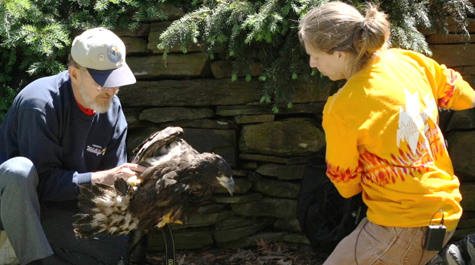Follow Azalea the eagle on line
On May 20, biologists from William & Mary’s Center for Conservation Biology eased Azalea from her nest at the Norfolk Botanical Gardens and, in front of a group of rapt raptor fans, fitted her with a backpack transmitter.
Azalea and other eagles hatched at the Norfolk Botanical Gardens for the past few years have built up quite a fan club, thanks to the eagle nest camera sponsored by WVEC-TV. The web-connected camera lets anyone with an Internet connection watch parenting behavior and follow the hatching and growth of baby eagles.
“They have a huge following—tens of millions of hits,” said Bryan Watts, director of the Center for Conservation Biology. “It’s one of the largest followings of any eagle cam in the world.”
The public’s connection with the baby eagles ended when the chicks grow up and leave the nest, flying out of camera range—until this year. Courtesy of the Center for Conservation Biology, Azalea’s fans can continue to follow her movements over the Internet after she leaves the nest. EagleTrak, a public web page, will let you monitor Azalea's travels. A blog, maintained by CCB Research Associate Reese Lukei, Jr., will follow Azalea as well, interpreting and giving context to her movements.
Azalea’s backpack lets center biologists track her through GPS (global positioning system), the same sort of satellite-based navigation increasingly used in cars. She isn’t the only eagle wearing a backpack, though. Watts said the CCB fitted six eagle chicks with the transmitters this year; last year, 12 chicks got transmitters. The public interest in Azalea and her family was a chance to combine research with public education.
“This year we decided that after the web cam is over, we thought it was an opportunity to have something available to the public and for us to learn more about eagle movements,” Watts said.
Azalea, like other bald eagle chicks, was fitted with her backpack about 55 days after hatching, Watts said. Even though she is about the size of a moderate chicken, Azalea will be immature enough to be dependent on her parents until about the end of June, Watts said.
“Eagles typically fledge at about 11 to 12 weeks of age,” he said. “The transmitter won’t be too interesting until that happens.”
Once fledged, Azalea will begin making short flights, returning to the nest to roost—and still very much dependent on her parents, Watts explained. Biologists don’t know much about this weaning period in the eagle life cycle, he said, noting that observations of Azalea and other transmitter-equipped chicks will fill in some blanks in the life history of the national bird. One of the unknowns is just when Azalea can be expected to leave her nest at the Norfolk Botanical Gardens.
“One of the things that we’re hoping to learn is the length of the dependency period,” Watts said. “If I had to guess, after she starts to fly I’d say she would stay within her home territory for as much as a month or so, then she’ll start to venture out beyond that. After the chicks are independent from their parents, it’s hard to say how far they’re going to wander. They might stay in the Tidewater area, but certainly they’re going to take flights up to the upper bay and maybe throughout the mid-Atlantic.”
In addition to the 18 eagle chicks, the Center for Conservation Biology also tracks adult eagles in the upper end of Chesapeake Bay. Azalea is the first eagle hatched in Hampton Roads to be fitted with a transmitter. The EagleTrak web site will show viewers Azalea’s location, updated every 24 hours.
 Skip to main content
Skip to main content



